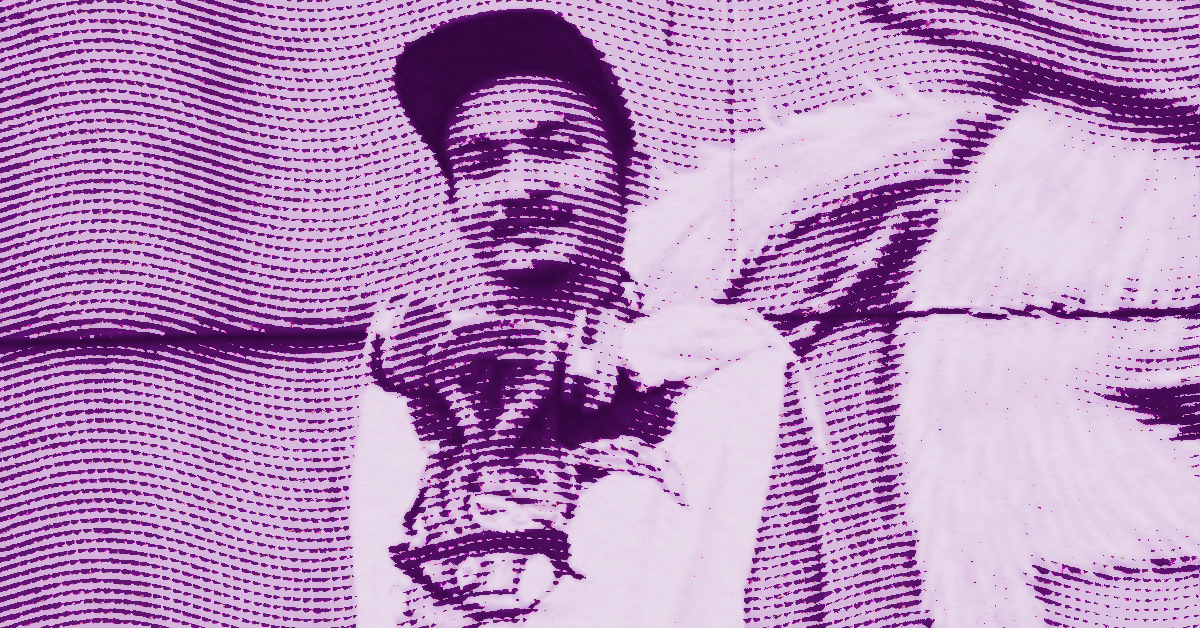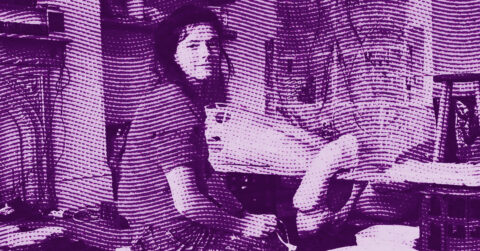Listen to me carefully, you bunch of snobs: Patcharapol Tangruen, known as Alex Face, is redefining Asian contemporary art with a poetic brutality that will make you forget your aesthetic certainties. This fifty-something Thai man, born in 1981 in Chachoengsao province, wields brush and spray can with a dexterity that would make Renaissance masters envious. But make no mistake: his art is not a mere technical demonstration. It is a wake-up call from the alleyways of Bangkok, a contemporary memento mori that questions our human condition with the subtlety of a scalpel and the force of a hurricane.
Since fatherhood struck him in 2009, Alex Face has abandoned his narcissistic self-portraits to create Mardi, this emblematic character now haunting walls worldwide. This child with prematurely aged eyes, dressed in a worn rabbit costume and endowed with an all-seeing third eye, embodies all the complexity of our era. Behind this seemingly innocent figure lies a philosophical depth that directly recalls the Dutch vanities of the 17th century and the revolutionary innovations of French impressionism.
A contemporary memento mori
Alex Face’s work fits into an artistic lineage as old as it is disturbing: that of the vanitas, a pictorial genre that emerged in 17th century Netherlands to remind viewers of the vanity of earthly pleasures and the inevitability of death. When Dutch masters like Pieter Claesz or Harmen Steenwijck arranged skulls, hourglasses, and faded flowers on their canvases, they sought to moralize their contemporaries enriched by maritime trade [1]. Alex Face continues this tradition but transposes it into our contemporary world with remarkable acuity.
Mardi, his favorite character, functions exactly like these baroque memento mori. It is no coincidence that the artist named his imaginary child after his own daughter: this figure becomes the vehicle of a deep existential anguish. Like the mortality symbols in Dutch vanities, Mardi confronts us with our finitude. His tired gaze, prematurely aged features, and vulnerable animal costume all contribute to making this child a powerful reminder of our fragility.
But Alex Face goes further than his Flemish predecessors. While traditional vanitas were content with inanimate objects to convey their message, the Thai artist breathes life into his allegory. Mardi is not a still life: he is a living, breathing creature who looks at us with painful wisdom. This personification of human vulnerability makes the message even more striking than the dusty skulls of old.
The recent evolution of Alex Face’s work towards floral compositions directly inspired by Dutch vanities confirms this lineage. In his series “Neon and Fire Vanitas” presented at the Dorothy Circus Gallery in 2024, the artist associates his iconic character with decomposing flowers, blazing butterflies, and golden elements. This synthesis between Baroque tradition and contemporary aesthetics demonstrates a profound understanding of the historical codes of memento mori.
Mardi’s third eye, a mystical attribute borrowed from Asian spiritual traditions, functions as a symbol of clairvoyance regarding the future. While Dutch vanitas used the hourglass to represent the passage of time, Alex Face employs this third eye to suggest an enhanced perception of our collective destiny. Mardi sees what we refuse to admit: environmental degradation, social injustice, the inexorable march towards an uncertain future.
This prophetic dimension fundamentally distinguishes Alex Face from traditional vanitas. Whereas Dutch masters preached resignation in the face of inevitable death, the Thai artist uses Mardi to warn about avoidable dangers. His contemporary vanity is not fatalistic: it is a call to action, an invitation to change course before it is too late. In this, Alex Face brilliantly updates a centuries-old genre for the challenges of our time.
The Impressionist legacy: Painting the light of Bangkok
Alex Face’s second major lineage connects him to the aesthetic revolution that was French Impressionism. This connection might seem unlikely: what could a Bangkok graffiti artist have in common with Claude Monet painting his water lilies in Giverny? Yet, the Thai artist explicitly claims this heritage and demonstrates it with troubling coherence.
“Impressionists were not different from street artists who paint graffiti on a wall,” declares Alex Face in a recent interview [2]. This statement, which might be taken as a joke, actually reveals a deep understanding of the revolutionary essence of the Impressionist movement. Like Monet and his contemporaries who abandoned their studios to paint outdoors, Alex Face left galleries to invest urban space.
The invention of the paint tube by American John G. Rand in 1841 freed the Impressionists from their studios, allowing them to directly capture the fleeting effects of natural light [3]. The aerosol spray can plays the same liberating role for Alex Face: it gives him the ability to create instantly, in the immediacy of the street, without preparation or artifice. This technical spontaneity fundamentally brings contemporary street art closer to the Impressionist revolution.
But the kinship goes far beyond the tools. Alex Face shares with the Impressionists the same obsession for capturing the present moment. His mural creations, subject to climatic hazards and human interventions, possess the same fragility that Monet sought to capture in his series of the Rouen Cathedrals or Haystacks. Ephemerality thus becomes an integral part of the artwork, reinforcing its message about the precariousness of existence.
The “Impressions” exhibition that Alex Face presented in New York in 2024 brilliantly materializes this lineage. The artist transposes Mardi into landscapes directly inspired by the French masters, creating compositions where his iconic character evolves among water lilies in the manner of Monet. These hybrid works demonstrate that the Impressionist lesson remains alive: painting is above all about capturing the particular quality of a moment, a light, an emotion.
This approach is rooted in the artist’s personal experience. Trained in reproducing Impressionist paintings at a Thai company, Alex Face learned to break down the technique of these masters. “I painted many reproductions and learned a lot. I even tried to mix exactly the same colors they used, but there are almost too many colors in those paintings for the eye to see,” he confides [4]. This technical training now allows him to engage on equal footing with his illustrious predecessors.
More deeply, Alex Face rediscovers the original subversive spirit of Impressionism. When the first Impressionists exhibited in 1874, the critics showered them with sarcasm, reproaching their works for their “unfinished” appearance and “sloppy” technique. Alex Face faces the same criticisms from contemporary art purists who struggle to recognize the legitimacy of street art. This historical recurrence is no coincidence: it reveals that true art always disturbs established conformism.
Finally, like the Impressionists who favored scenes of everyday life over grand historical compositions, Alex Face finds his inspiration in the mundane of Bangkok. His Mardi evolve in familiar environments: markets, alleys, and dumps, giving a poetic dimension to the prosaic. This democratization of the artistic subject, this attention paid to the ordinary transformed into the sublime, constitutes one of the most enduring legacies of Impressionism.
The contemporary synthesis: A global art with local roots
Alex Face’s originality lies in his ability to merge these two seemingly opposing traditions, the Baroque memento mori and the Impressionist hedonism, into a perfectly contemporary synthesis. This artistic alchemy produces a unique visual language that simultaneously speaks to both Asian and Western art lovers, experts and novices alike.
This universality never sacrifices cultural specificity. Mardi carries within her the entire Thai identity: her third eye evokes Buddhist traditions, her animal costumes refer to local animist beliefs, her urban environments reflect the social reality of Bangkok. But these particular references are articulated in a discourse understandable by all, touching on universal concerns such as childhood, fatherhood, and environmental anxiety.
Alex Face’s technical evolution accompanies this conceptual maturation. Starting from a simple personal tag, his face reproduced on the walls of the capital, he developed an increasingly sophisticated iconographic repertoire. His latest works, which blend traditional oil painting and street techniques, demonstrate exceptional technical mastery. The artist moves easily from the wall to the canvas, from large format to intimate work, proving that urban art can claim the same excellence as academic art.
This technical versatility is accompanied by a sharp political awareness. Alex Face does not just decorate walls: he questions the changes in Thai society. The rapid industrialization of his homeland, the disappearance of rice fields in favor of factories, rural exodus emptying the countryside, all these phenomena find their visual translation in Mardi’s universe. The worried child becomes the privileged witness of a rapidly changing world.
The international recognition Alex Face enjoys today, with exhibitions in London, New York, Rome, and Los Angeles, has not disconnected him from his popular roots. Faithful to the spirit of street art, he continues to paint in the disadvantaged neighborhoods of Bangkok, maintaining this direct dialogue with the population that constitutes the very essence of urban art. This loyalty to his origins distinguishes Alex Face from many contemporary artists tempted by the gentrification of the gallery world.
His personal trajectory perfectly embodies the transformations of contemporary Asian art. Trained in Western codes but nourished by Eastern spirituality, urban but sensitive to environmental issues, popular but technically sophisticated, Alex Face represents this new generation of artists who reject traditional divides between high art and popular art, between local and global, between tradition and modernity.
Towards an aesthetics of responsibility
The Alex Face phenomenon goes far beyond a mere artistic success story. It reveals the profound changes that contemporary art is undergoing at the beginning of the 21st century. Faced with the ecological and social challenges of our time, many artists abandon the traditional critical stance to embrace a new responsibility. Alex Face embodies this evolution: his art no longer merely reflects the world, it intends to change it.
This transformative ambition relies on a remarkably effective strategy of dissemination. By investing public space, Alex Face short-circuits the traditional circuits of contemporary art. His Mardi directly reach urban populations, without institutional mediation. This radical democratization of access to art may be his most enduring contribution to aesthetic history.
The future will tell whether this aesthetics of responsibility can renew itself without losing its subversive strength. Alex Face has now achieved this international recognition which can be a trap for artists coming from the street. Will he be able to maintain the authenticity of his message while evolving within the spheres of the art market? His ability to resolve this tension will determine the durability of his work.
One thing remains certain: with Mardi, Alex Face has created one of the most powerful artistic figures of his generation. This child with a worried gaze will haunt our collective conscience for a long time, reminding us that true art is always born from urgency and love. In a world saturated with images, Alex Face has managed to create an image that matters. That is already a lot. It may be the essential.
- Vanitas: Paintings by the Dutch Old Masters Inspired by Life and Death, MyModernMet, 2022
- “The Impressionists Were No Different from Street Artists Spray-Painting Graffiti on a Wall”: An Interview with Alex Face, Juxtapoz Magazine, 2024
- Plein-air painting, Encyclopædia Britannica, 1998
- Alex Face ‘Impressions’, Vertical Gallery, 2024
















